check engine RENAULT TWINGO 2009 2.G Chasiss ESP Workshop Manual
[x] Cancel search | Manufacturer: RENAULT, Model Year: 2009, Model line: TWINGO, Model: RENAULT TWINGO 2009 2.GPages: 101
Page 12 of 101
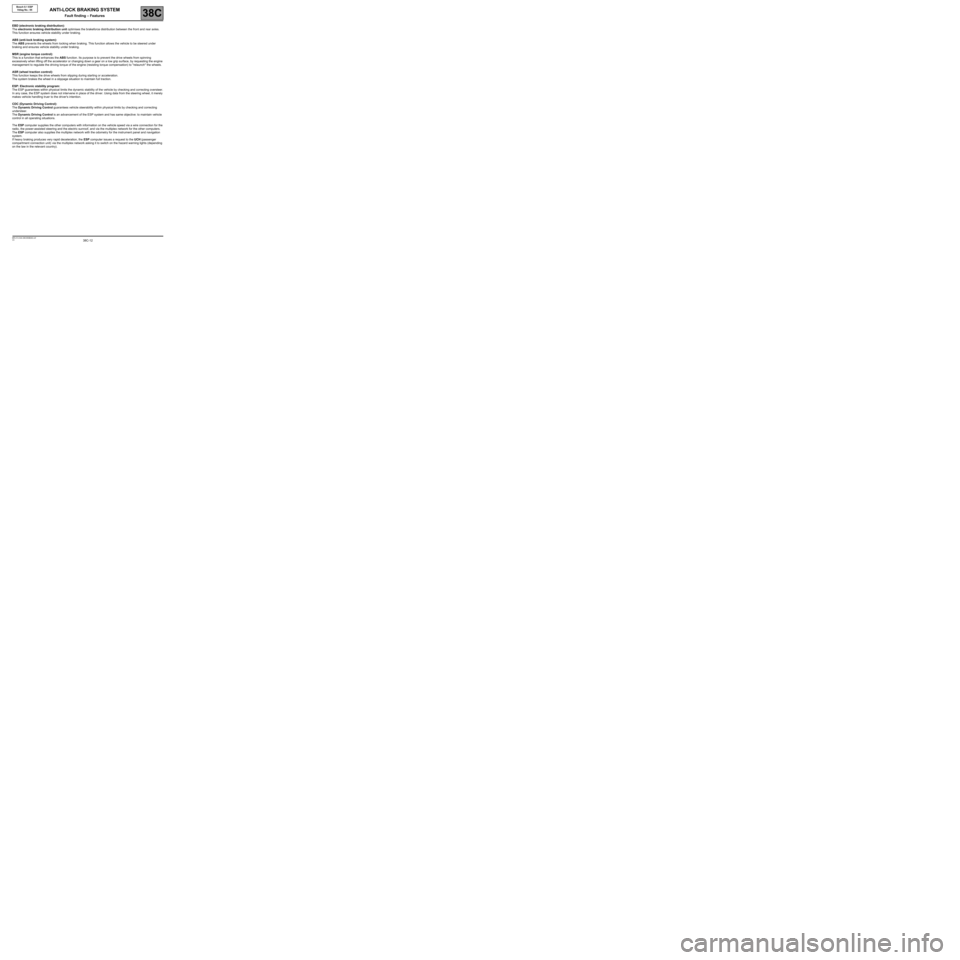
38C-12V3 MR-413-X44-38C050$040.mif
38C
Bosch 8.1 ESP
Vdiag No.: 05
EBD (electronic braking distribution):
The electronic braking distribution unit optimises the brakeforce distribution between the front and rear axles.
This function ensures vehicle stability under braking.
ABS (anti-lock braking system):
The ABS prevents the wheels from locking when braking. This function allows the vehicle to be steered under
braking and ensures vehicle stability under braking.
MSR (engine torque control):
This is a function that enhances the ABS function. Its purpose is to prevent the drive wheels from spinning
excessively when lifting off the accelerator or changing down a gear on a low grip surface, by requesting the engine
management to regulate the driving torque of the engine (resisting torque compensation) to "relaunch" the wheels.
ASR (wheel traction control):
This function keeps the drive wheels from slipping during starting or acceleration.
The system brakes the wheel in a slippage situation to maintain full traction.
ESP: Electronic stability program:
The ESP guarantees within physical limits the dynamic stability of the vehicle by checking and correcting oversteer.
In any case, the ESP system does not intervene in place of the driver. Using data from the steering wheel, it merely
makes vehicle handling truer to the driver's intention.
CDC (Dynamic Driving Control):
The Dynamic Driving Control guarantees vehicle steerability within physical limits by checking and correcting
understeer.
The Dynamic Driving Control is an advancement of the ESP system and has same objective: to maintain vehicle
control in all operating situations.
The ESP computer supplies the other computers with information on the vehicle speed via a wire connection for the
radio, the power-assisted steering and the electric sunroof, and via the multiplex network for the other computers.
The ESP computer also supplies the multiplex network with the odometry for the instrument panel and navigation
system.
If heavy braking produces very rapid deceleration, the ESP computer issues a request to the UCH (passenger
compartment connection unit) via the multiplex network asking it to switch on the hazard warning lights (depending
on the law in the relevant country).
ANTI-LOCK BRAKING SYSTEM
Fault finding – Features
Page 16 of 101
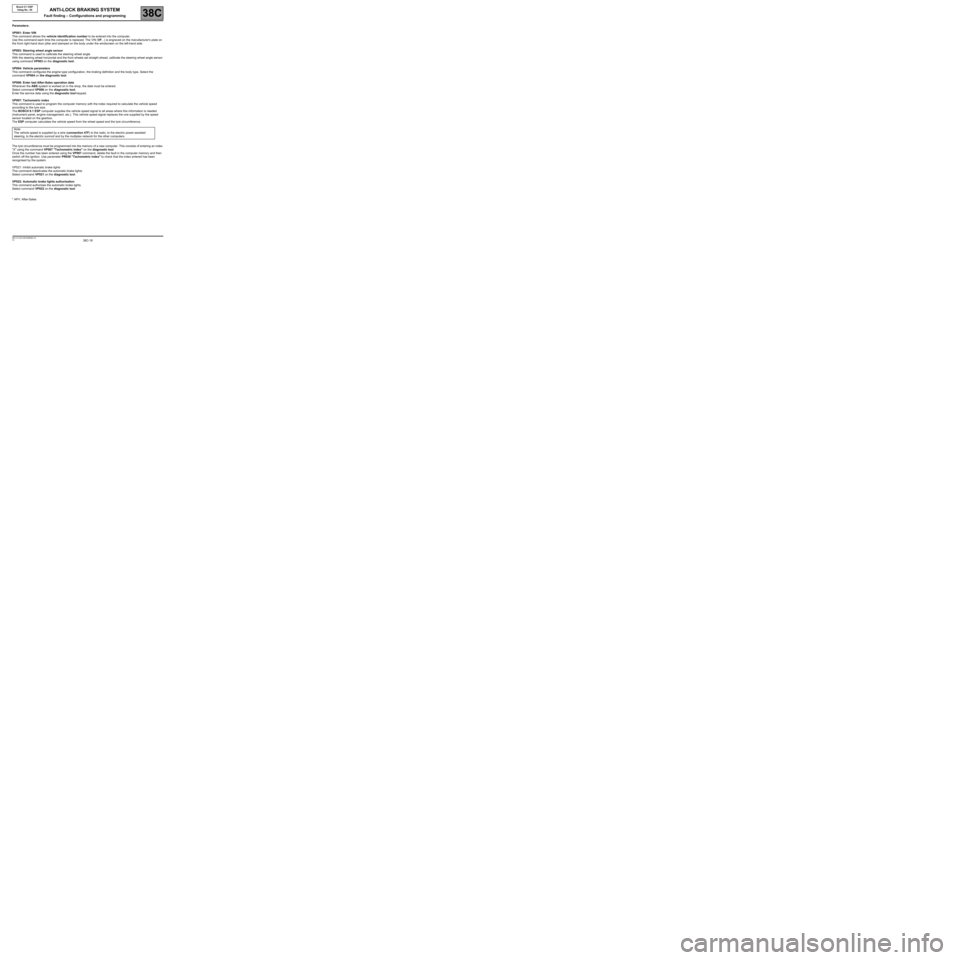
38C-16V3 MR-413-X44-38C050$080.mif
38C
Bosch 8.1 ESP
Vdiag No.: 05
Parameters:
VP001: Enter VIN
This command allows the vehicle identification number to be entered into the computer.
Use this command each time the computer is replaced. The VIN (VF...) is engraved on the manufacturer's plate on
the front right-hand door pillar and stamped on the body under the windscreen on the left-hand side.
VP003: Steering wheel angle sensor
This command is used to calibrate the steering wheel angle.
With the steering wheel horizontal and the front wheels set straight ahead, calibrate the steering wheel angle sensor
using command VP003 on the diagnostic tool.
VP004: Vehicle parameters
This command configures the engine type configuration, the braking definition and the body type. Select the
command VP004 on the diagnostic tool.
VP006: Enter last After-Sales operation date
Whenever the ABS system is worked on in the shop, the date must be entered.
Select command VP006 on the diagnostic tool.
Enter the service date using the diagnostic tool keypad.
VP007: Tachometric index
This command is used to program the computer memory with the index required to calculate the vehicle speed
according to the tyre size.
The BOSCH 8.1 ESP computer supplies the vehicle speed signal to all areas where this information is needed
(instrument panel, engine management, etc.). This vehicle speed signal replaces the one supplied by the speed
sensor located on the gearbox.
The ESP computer calculates the vehicle speed from the wheel speed and the tyre circumference.
The tyre circumference must be programmed into the memory of a new computer. This consists of entering an index
"X" using the command VP007 "Tachometric index" on the diagnostic tool.
Once the number has been entered using the VP007 command, delete the fault in the computer memory and then
switch off the ignition. Use parameter PR030 "Tachometric index" to check that the index entered has been
recognised by the system.
VP021: Inhibit automatic brake lights
This command deactivates the automatic brake lights.
Select command VP021 on the diagnostic tool.
VP022: Automatic brake lights authorisation
This command authorises the automatic brake lights.
Select command VP022 on the diagnostic tool.
* APV: After-SalesNote:
The vehicle speed is supplied by a wire (connection 47F) to the radio, to the electric power-assisted
steering, to the electric sunroof and by the multiplex network for the other computers.
ANTI-LOCK BRAKING SYSTEM
Fault finding – Configurations and programming
Page 19 of 101
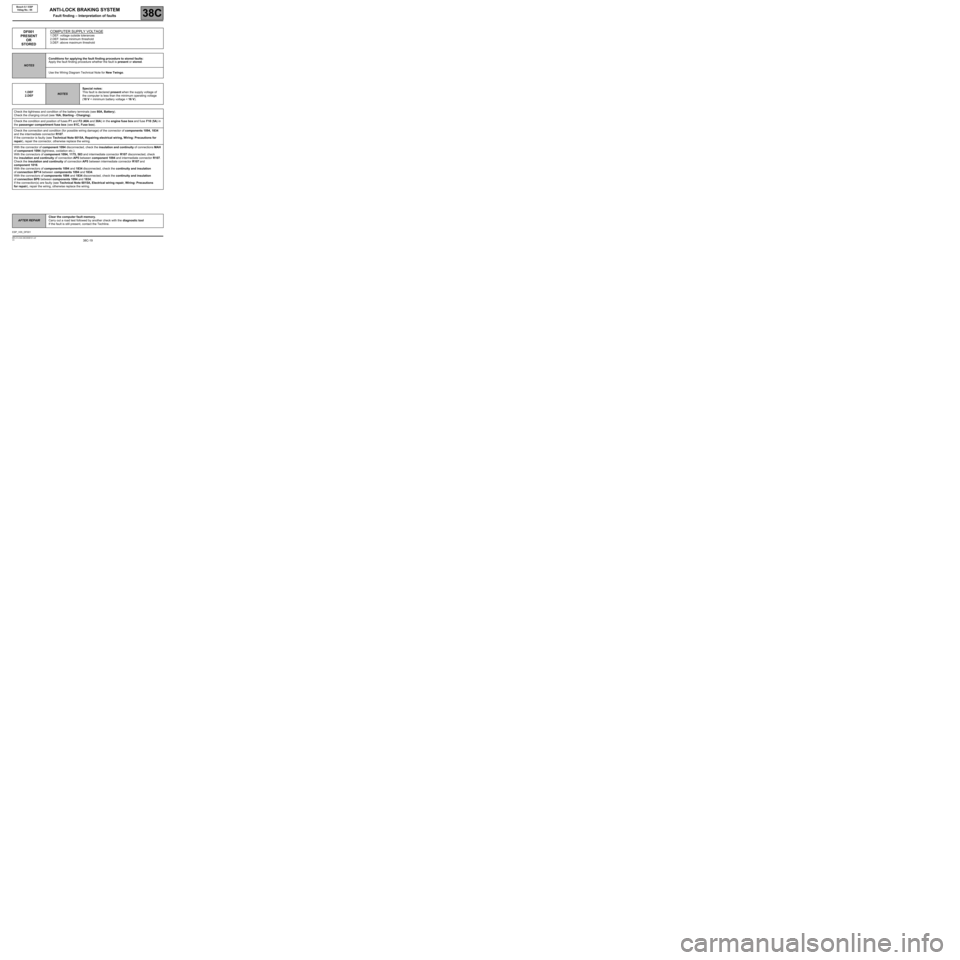
38C-19
AFTER REPAIRClear the computer fault memory.
Carry out a road test followed by another check with the diagnostic tool
If the fault is still present, contact the Techline.
V3 MR-413-X44-38C050$101.mif
38C
Bosch 8.1 ESP
Vdiag No.: 05
DF001
PRESENT
OR
STOREDCOMPUTER SUPPLY VOLTAGE
1.DEF: voltage outside tolerances
2.DEF: below minimum threshold
3.DEF: above maximum threshold
NOTESConditions for applying the fault finding procedure to stored faults:
Apply the fault finding procedure whether the fault is present or stored.
Use the Wiring Diagram Technical Note for New Twingo.
1.DEF
2.DEF
NOTESSpecial notes:
This fault is declared present when the supply voltage of
the computer is less than the minimum operating voltage
(10 V < minimum battery voltage < 16 V).
Check the tightness and condition of the battery terminals (see 80A, Battery).
Check the charging circuit (see 16A, Starting - Charging).
Check the condition and position of fuses F1 and F2 (40A and 30A) in the engine fuse box and fuse F10 (5A) in
the passenger compartment fuse box (see 81C, Fuse box).
Check the connection and condition (for possible wiring damage) of the connector of components 1094, 1834
and the intermediate connector R107.
If the connector is faulty (see Technical Note 6015A, Repairing electrical wiring, Wiring: Precautions for
repair), repair the connector, otherwise replace the wiring.
With the connector of component 1094 disconnected, check the insulation and continuity of connections MAH
of component 1094 (tightness, oxidation etc.).
With the connectors of component 1094, 1175, 583 and intermediate connector R107 disconnected, check
the insulation and continuity of connection AP5 between component 1094 and intermediate connector R107.
Check the insulation and continuity of connection AP5 between intermediate connector R107 and
component 1016.
With the connectors of components 1094 and 1834 disconnected, check the continuity and insulation
of connection BP14 between components 1094 and 1834.
With the connectors of components 1094 and 1834 disconnected, check the continuity and insulation
of connection BP8 between components 1094 and 1834.
If the connection(s) are faulty (see Technical Note 6015A, Electrical wiring repair, Wiring: Precautions
for repair), repair the wiring, otherwise replace the wiring.
ANTI-LOCK BRAKING SYSTEM
Fault finding – Interpretation of faults
ESP_V05_DF001
Page 27 of 101
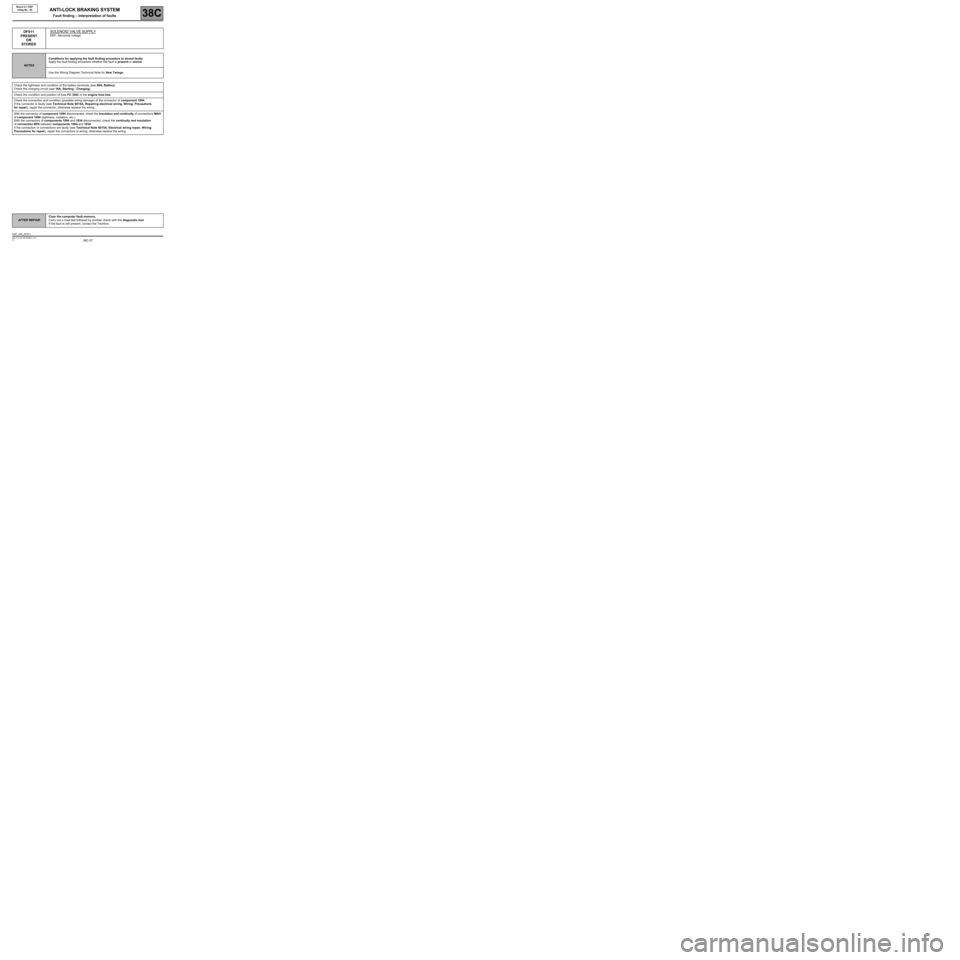
38C-27
AFTER REPAIRClear the computer fault memory.
Carry out a road test followed by another check with the diagnostic tool
If the fault is still present, contact the Techline.
V3 MR-413-X44-38C050$101.mif
ANTI-LOCK BRAKING SYSTEM
Fault finding – Interpretation of faults38C
Bosch 8.1 ESP
Vdiag No.: 05
DF011
PRESENT
OR
STOREDSOLENOID VALVE SUPPLY
DEF: Abnormal voltage
NOTESConditions for applying the fault finding procedure to stored faults:
Apply the fault finding procedure whether the fault is present or stored.
Use the Wiring Diagram Technical Note for New Twingo.
Check the tightness and condition of the battery terminals (see 80A, Battery).
Check the charging circuit (see 16A, Starting - Charging).
Check the condition and position of fuse F2 (30A) in the engine fuse box.
Check the connection and condition (possible wiring damage) of the connector of component 1094.
If the connector is faulty (see Technical Note 6015A, Repairing electrical wiring, Wiring: Precautions
for repair), repair the connector, otherwise replace the wiring.
With the connector of component 1094 disconnected, check the insulation and continuity of connections MAH
of component 1094 (tightness, oxidation, etc.).
With the connectors of components 1094 and 1834 disconnected, check the continuity and insulation
of connection BP8 between components 1094 and 1834.
If the connection or connections are faulty (see Technical Note 6015A, Electrical wiring repair, Wiring:
Precautions for repair), repair the connectors or wiring, otherwise replace the wiring.
ESP_V05_DF011
Page 28 of 101
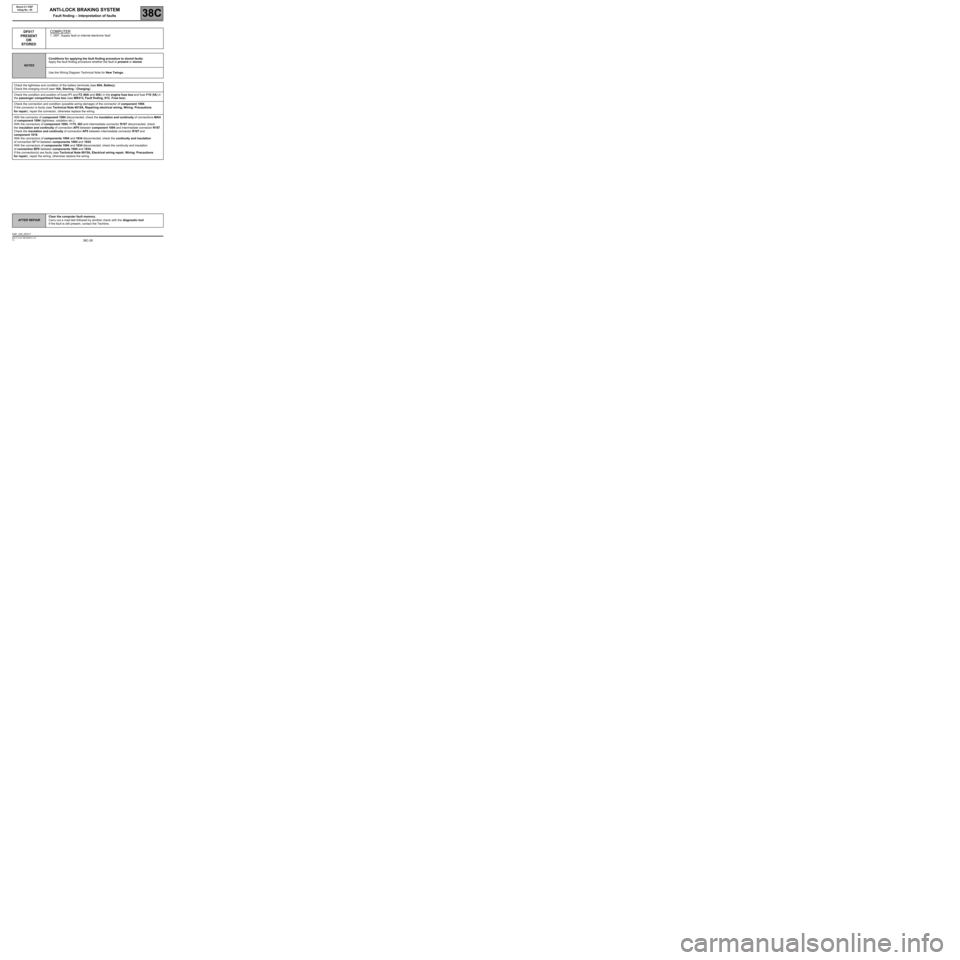
38C-28
AFTER REPAIRClear the computer fault memory.
Carry out a road test followed by another check with the diagnostic tool
If the fault is still present, contact the Techline.
V3 MR-413-X44-38C050$101.mif
ANTI-LOCK BRAKING SYSTEM
Fault finding – Interpretation of faults38C
Bosch 8.1 ESP
Vdiag No.: 05
DF017
PRESENT
OR
STOREDCOMPUTER
1. DEF: Supply fault or internal electronic fault
NOTESConditions for applying the fault finding procedure to stored faults:
Apply the fault finding procedure whether the fault is present or stored.
Use the Wiring Diagram Technical Note for New Twingo.
Check the tightness and condition of the battery terminals (see 80A, Battery).
Check the charging circuit (see 16A, Starting - Charging).
Check the condition and position of fuses F1 and F2 (40A and 30A) in the engine fuse box and fuse F10 (5A) in
the passenger compartment fuse box (see MR413, Fault finding, 81C, Fuse box).
Check the connection and condition (possible wiring damage) of the connector of component 1094.
If the connector is faulty (see Technical Note 6015A, Repairing electrical wiring, Wiring: Precautions
for repair), repair the connector, otherwise replace the wiring.
With the connector of component 1094 disconnected, check the insulation and continuity of connections MAH
of component 1094 (tightness, oxidation etc.).
With the connectors of component 1094, 1175, 583 and intermediate connector R107 disconnected, check
the insulation and continuity of connection AP5 between component 1094 and intermediate connector R107.
Check the insulation and continuity of connection AP5 between intermediate connector R107 and
component 1016.
With the connectors of components 1094 and 1834 disconnected, check the continuity and insulation
of connection BP14 between components 1094 and 1834.
With the connectors of components 1094 and 1834 disconnected, check the continuity and insulation
of connection BP8 between components 1094 and 1834.
If the connection(s) are faulty (see Technical Note 6015A, Electrical wiring repair, Wiring: Precautions
for repair), repair the wiring, otherwise replace the wiring.
ESP_V05_DF017
Page 29 of 101
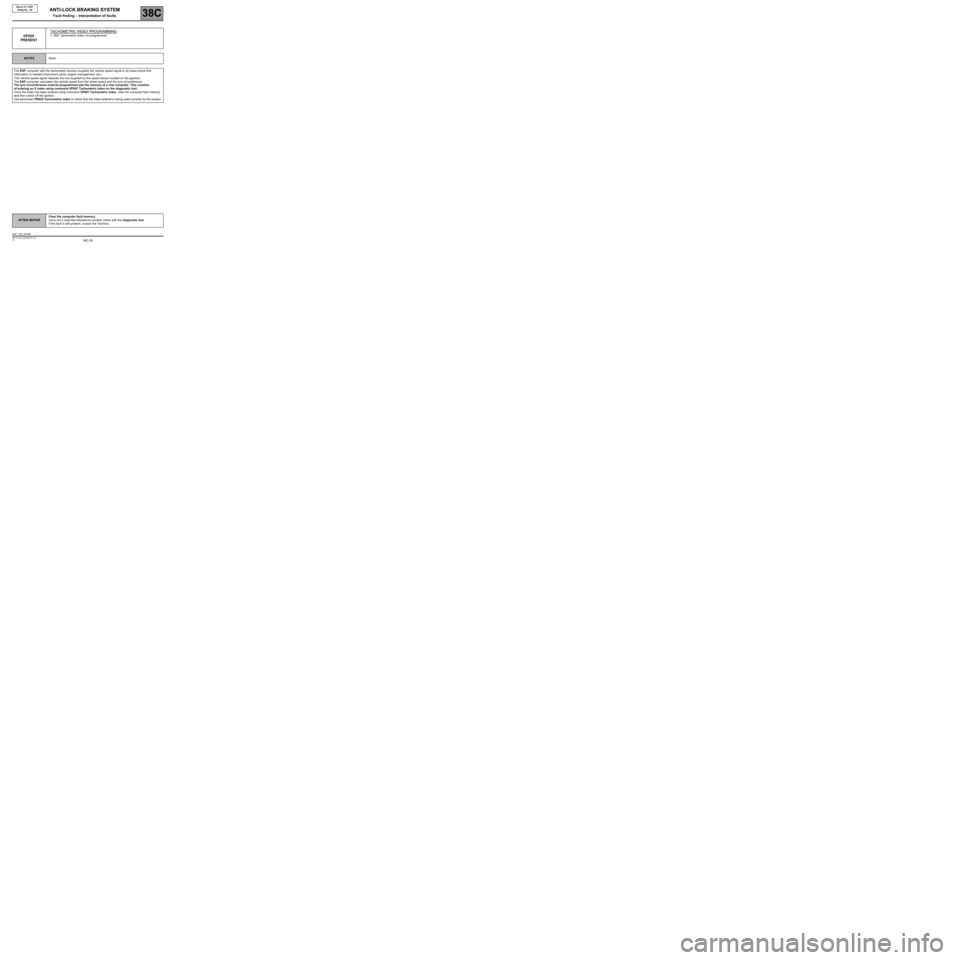
38C-29
AFTER REPAIRClear the computer fault memory.
Carry out a road test followed by another check with the diagnostic tool
If the fault is still present, contact the Techline.
V3 MR-413-X44-38C050$101.mif
ANTI-LOCK BRAKING SYSTEM
Fault finding – Interpretation of faults38C
Bosch 8.1 ESP
Vdiag No.: 05
DF020
PRESENTTACHOMETRIC INDEX PROGRAMMING1. DEF: tachometric index not programmed
NOTESNone.
The ESP computer with the tachometric function supplies the vehicle speed signal to all areas where this
information is needed (instrument panel, engine management, etc.).
This vehicle speed signal replaces the one supplied by the speed sensor located on the gearbox.
The ESP computer calculates the vehicle speed from the wheel speed and the tyre circumference.
The tyre circumference must be programmed into the memory of a new computer. This consists
of entering an X index using command VP007 Tachometric index on the diagnostic tool.
Once the index has been entered using command VP007 Tachometric index, clear the computer fault memory
and then switch off the ignition.
Use parameter PR030 Tachometric index to check that the index entered is being used correctly by the system.
ESP_V05_DF020
Page 37 of 101
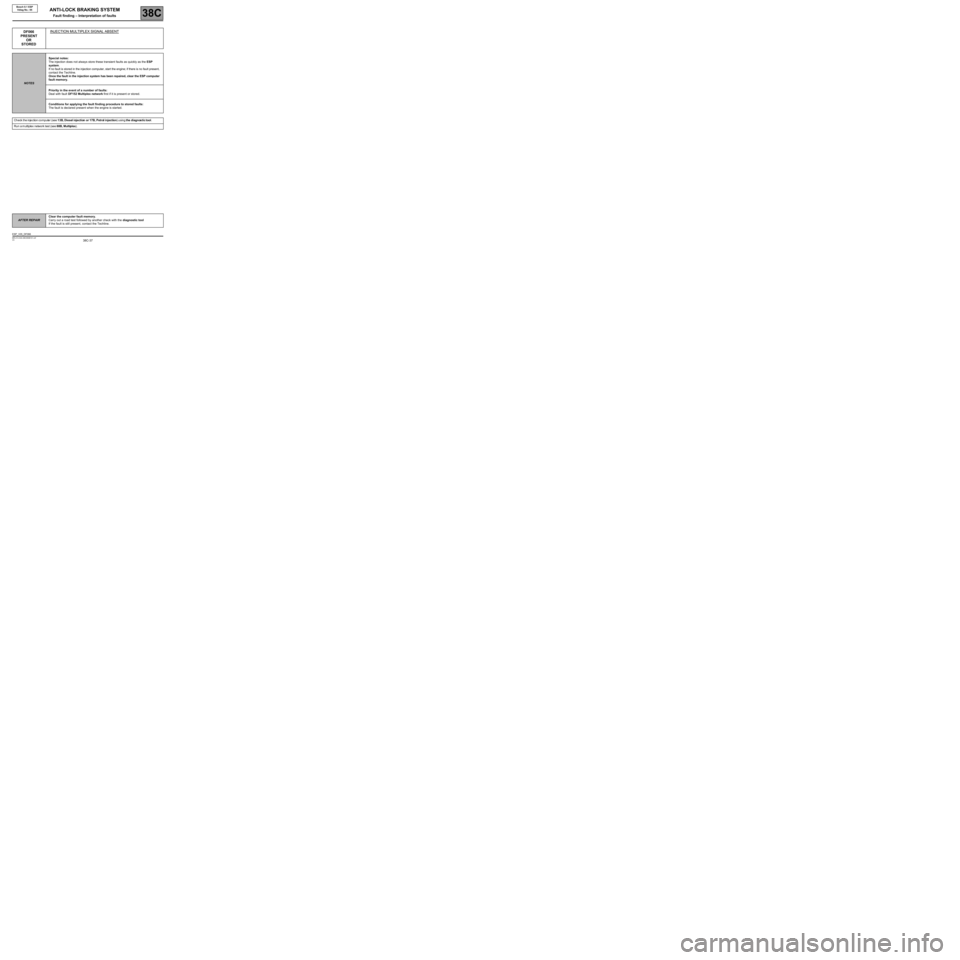
38C-37
AFTER REPAIRClear the computer fault memory.
Carry out a road test followed by another check with the diagnostic tool
If the fault is still present, contact the Techline.
V3 MR-413-X44-38C050$101.mif
ANTI-LOCK BRAKING SYSTEM
Fault finding – Interpretation of faults38C
Bosch 8.1 ESP
Vdiag No.: 05
DF066
PRESENT
OR
STOREDINJECTION MULTIPLEX SIGNAL ABSENT
NOTESSpecial notes:
The injection does not always store these transient faults as quickly as the ESP
system.
If no fault is stored in the injection computer, start the engine; if there is no fault present,
contact the Techline.
Once the fault in the injection system has been repaired, clear the ESP computer
fault memory.
Priority in the event of a number of faults:
Deal with fault DF152 Multiplex network first if it is present or stored.
Conditions for applying the fault finding procedure to stored faults:
The fault is declared present when the engine is started.
Check the injection computer (see13B, Diesel injection or 17B, Petrol injection)usingthe diagnostic tool.
Ru n a m ultiple xnetwork test (see88B, Multiplex).
ESP_V05_DF066
Page 48 of 101
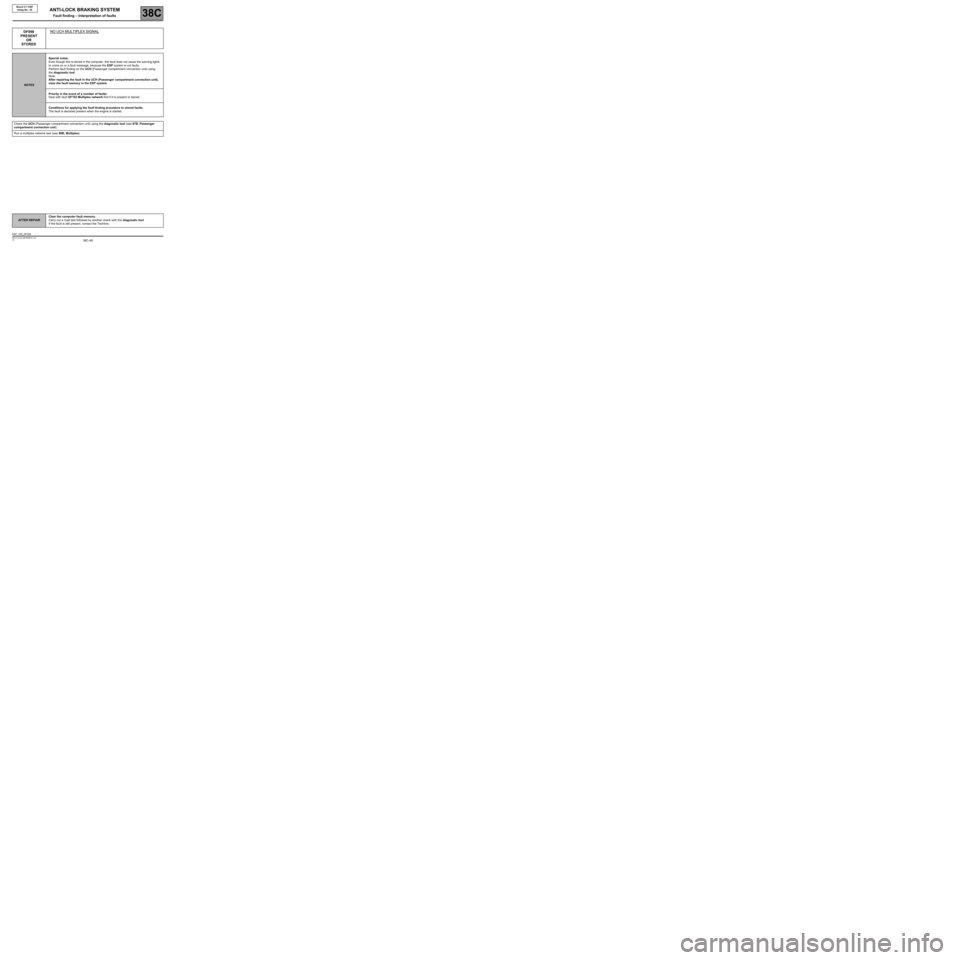
38C-48
AFTER REPAIRClear the computer fault memory.
Carry out a road test followed by another check with the diagnostic tool
If the fault is still present, contact the Techline.
V3 MR-413-X44-38C050$101.mif
ANTI-LOCK BRAKING SYSTEM
Fault finding – Interpretation of faults38C
Bosch 8.1 ESP
Vdiag No.: 05
DF098
PRESENT
OR
STOREDNO UCH MULTIPLEX SIGNAL
NOTESSpecial notes:
Even though this is stored in the computer, this fault does not cause the warning lights
to come on or a fault message, because the ESP system is not faulty.
Perform fault finding on the UCH (Passenger compartment connection unit) using
the diagnostic tool.
Note:
After repairing the fault in the UCH (Passenger compartment connection unit),
clear the fault memory in the ESP system.
Priority in the event of a number of faults:
Deal with fault DF152 Multiplex network first if it is present or stored.
Conditions for applying the fault finding procedure to stored faults:
The fault is declared present when the engine is started.
Check the UCH (Passenger compartment connection unit) using the diagnostic tool (see 87B, Passenger
compartment connection unit).
Run a multiplex network test (see 88B, Multiplex).
ESP_V05_DF098
Page 52 of 101
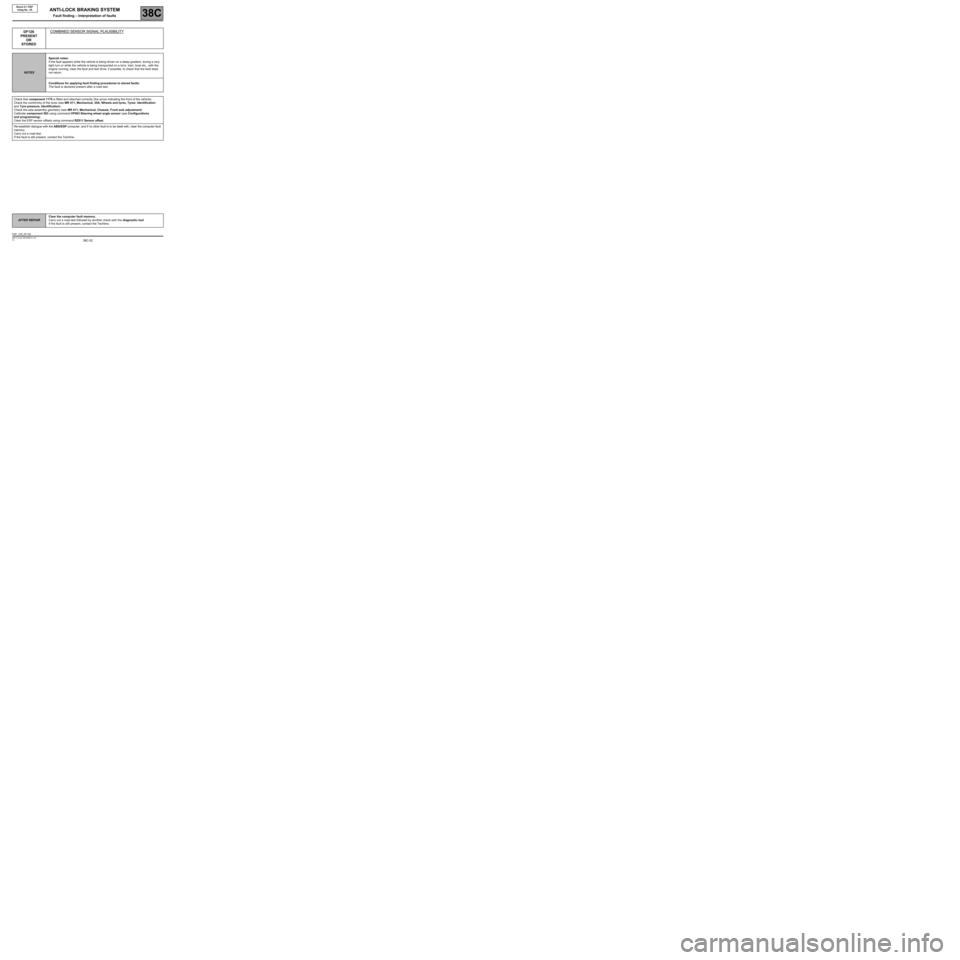
38C-52
AFTER REPAIRClear the computer fault memory.
Carry out a road test followed by another check with the diagnostic tool
If the fault is still present, contact the Techline.
V3 MR-413-X44-38C050$101.mif
ANTI-LOCK BRAKING SYSTEM
Fault finding – Interpretation of faults38C
Bosch 8.1 ESP
Vdiag No.: 05
DF126
PRESENT
OR
STOREDCOMBINED SENSOR SIGNAL PLAUSIBILITY
NOTESSpecial notes:
If the fault appears while the vehicle is being driven on a steep gradient, during a very
tight turn or while the vehicle is being transported on a lorry, train, boat etc., with the
engine running, clear the fault and test drive, if possible, to check that the fault does
not return.
Conditions for applying fault finding procedures to stored faults:
The fault is declared present after a road test.
Check that component 1175 is fitted and attached correctly (the arrow indicating the front of the vehicle).
Check the conformity of the tyres (see MR 411, Mechanical, 35A, Wheels and tyres, Tyres: Identification
and Tyre pressure, Identification).
Check the axle assembly geometry (see MR 411, Mechanical, Chassis, Front axle adjustment).
Calibrate component 583 using command VP003 Steering wheel angle sensor (see Configurations
and programming).
Clear the ESP sensor offsets using command RZ011 Sensor offset.
Re-establish dialogue with the ABS/ESP computer, and if no other fault is to be dealt with, clear the computer fault
memory.
Carry out a road test.
If the fault is still present, contact the Techline.
ESP_V05_DF126
Page 55 of 101
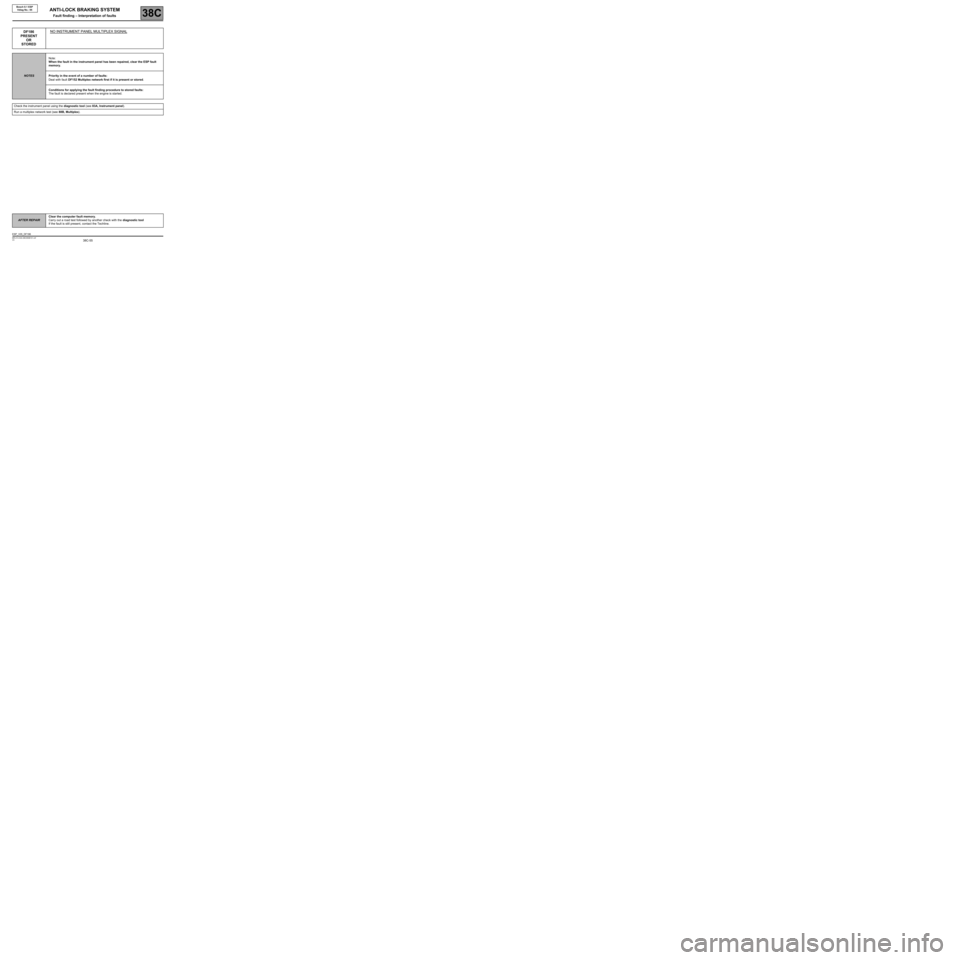
38C-55
AFTER REPAIRClear the computer fault memory.
Carry out a road test followed by another check with the diagnostic tool
If the fault is still present, contact the Techline.
V3 MR-413-X44-38C050$101.mif
ANTI-LOCK BRAKING SYSTEM
Fault finding – Interpretation of faults38C
Bosch 8.1 ESP
Vdiag No.: 05
DF186
PRESENT
OR
STOREDNO INSTRUMENT PANEL MULTIPLEX SIGNAL
NOTESNote:
When the fault in the instrument panel has been repaired, clear the ESP fault
memory.
Priority in the event of a number of faults:
Deal with fault DF152 Multiplex network first if it is present or stored.
Conditions for applying the fault finding procedure to stored faults:
The fault is declared present when the engine is started.
Check the instrument panel using the diagnostic tool (see 83A, Instrument panel).
Run a multiplex network test (see 88B, Multiplex).
ESP_V05_DF186